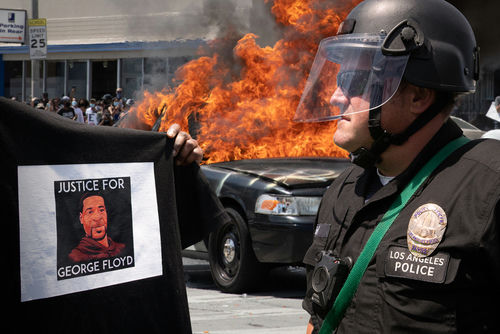When a decorated Marine veteran becomes the most wanted man in Texas after a violent ICE facility ambush, you start to wonder just how far the chaos at our border and the erosion of law and order can go before common sense finally returns to American governance.
Texas ICE Facility Attacked: The Anatomy of a July 4th Ambush
On Independence Day, while most Americans were celebrating freedom, ten individuals—reportedly coordinated by Benjamin Hanil Song, a Marine Corps veteran—launched a paramilitary-style ambush on the Prairieland ICE Detention Center. Investigators say the group lured officers outside using fireworks and spray paint, then opened fire from a wooded area. One Alvarado Police officer and a correctional officer were wounded before law enforcement responded, making arrests at the scene. According to officials, some suspects previously participated in radical protest movements, including Occupy Dallas, raising troubling questions about the escalation from street activism to armed violence targeting law enforcement and federal facilities.
The facility, already a magnet for anti-ICE protests, now finds itself at the center of a nationwide debate on the consequences of unchecked activism, weak borders, and the willingness of some to take the law into their own hands. The attack disrupted operations, forced emergency lockdowns, and left the community in a state of anxiety. Federal and local investigators are working overtime, and the FBI has issued a $25,000 reward for information leading to Song’s arrest. Acting US Attorney Nancy E. Larson praised the rapid law enforcement response but warned that Song remains armed, dangerous, and on the loose.
Who Is Benjamin Hanil Song and Why Did This Happen?
Benjamin Hanil Song, the central figure in this attack, is a former Marine Corps Reservist who, by all accounts, should have been the model citizen and defender of American values. Instead, law enforcement describes him as a fugitive, a ring leader in a plot that left officers wounded and a nation asking what led a veteran to cross the line from protest to terrorism. Song’s alleged co-conspirators include activists previously arrested at anti-ICE demonstrations, suggesting an ideological blend of anti-law enforcement sentiment and radical anti-detention activism. The FBI’s manhunt for Song is now front-page news, and with a $25,000 bounty on his head, authorities are urging the public to remain vigilant.
Song’s role as a fugitive, rather than a hero, is a stark reminder that even our veterans—often the bedrock of American strength—are not immune from being swept up in the chaos wrought by years of failed border policy, defunded law enforcement, and relentless demonization of ICE and police. The fact that ideological radicalism can morph so quickly into violence should shock no one paying attention to the trajectory of modern protest culture. When society spends years excusing lawlessness in the name of “activism,” this is the result.
Beyond Protest: From Civil Disobedience to Armed Extremism
The July 4th Prairieland attack is not just a local crime story—it’s a cautionary tale about the disastrous consequences of allowing anti-ICE rhetoric and radical activism to fester unchecked. Several of the arrested suspects have protest backgrounds, with some directly linked to Occupy Dallas and other anti-law enforcement movements. What used to be marches and sit-ins has now escalated, in this case, to attempted murder and terrorism charges. Bonds have been set at $10 million for each suspect, underscoring the gravity of the crimes and the seriousness with which prosecutors are treating the attack.
The legal ramifications are enormous, but the social and political ones are even bigger. Communities near ICE facilities now face heightened security and a climate of fear, while critics of current policy warn that soft approaches to protest and border security are emboldening the most extreme elements. Law enforcement and families of the wounded officers are left to pick up the pieces as national leaders debate whether this is a one-off or the shape of things to come.
Impact, Outrage, and the Path Forward
In the immediate aftermath, the Prairieland Detention Center has ramped up security, local residents are on edge, and law enforcement is marshaling every resource to catch Song. The broader impact is already being felt: calls for increased security at federal detention sites, a renewed focus on the dangers of unchecked protest culture, and yet another round of finger-pointing over who is responsible for policing the line between activism and extremism. The attack is fueling debates over the wisdom of current border and detention policies, especially in a political climate where protecting “the rights of the accused” sometimes seems to take precedence over protecting law enforcement and law-abiding citizens.
The fact that such an attack was even possible is a damning indictment of the climate fostered by years of open borders, anti-police rhetoric, and a government too often willing to appease the most radical voices at the expense of public safety. For the families of wounded officers, and for a nation still reeling from the spectacle of a veteran-turned-fugitive, the only acceptable outcome is swift justice and a national reckoning with the policies and cultural rot that made this tragedy possible in the first place.
Sources:
US Attorney’s Office, Northern District of Texas

